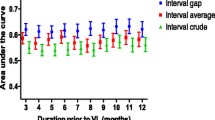Abstract
This study aimed to evaluate adherence to antiretroviral treatment (ART) among HIV + adults, assess its association with HIV viral load (VL) and identify factors associated to adherence. A survey involving a random sample of adults followed at a HIV/AIDS reference center in São Paulo city, Brazil, from 2007 to 2009 was done. A questionnaire was applied and data were retrieved from the pharmacy and medical records. The study involved 292 subjects: 70.2% men; median age: 43 years; median duration of ART: 8 years. 89.3% self-reported taken all prescribed pills in the last 3 days but only 39.3% picked up ≥95% of the prescribed ART from the pharmacy in the last 12 months. At the multivariate analysis having symptoms prior to ART, taking fewer ART pills, and not missing medical appointments were independently associated to higher adherence. Adherence was strongly associated with undetectable HIV VL. Rates of undetectable HIV VL did not differ from 80 to ≥95% of adherence.
Resúmen
Este trabajo tuvo como objetivo evaluar en adultos con VIH, la adhesión al tratamiento antiretroviral (TAR), su asociación con la carga viral (CV-VIH) e identificar factores asociados a la adhesión. Se realizó una encuesta a una muestra aleatoria de adultos (N = 292) asistidos por el centro de referencia de VIH/SIDA en la ciudad de San Pablo (2007–2009). Se extrajeron datos de registros médicos y de farmacia. Este estudio comprendió 70,2% hombres; edad media: 43 años; duración media del TAR: 8 años. 89,3% autorelató tomar todas las píldoras prescriptas del TAR en los últimos 3 días; pero sólo 39,3% levantó de la farmacia en los últimos 12 meses, ≥95% de las mismas. En el análisis multivariado, no perderse ninguna cita médica, tener síntomas antes del TAR y tomar menos píldoras se asociaron independientemente a la alta adhesión. Ésta se asoció fuertemente con CV-VIH indetectable, cuyas tasas no difirieron de 80 a 95% de adhesión.

Similar content being viewed by others
References
Ministério da Saúde/Secretaria de Vigilância em Saúde/Programa DST/AIDS. Brazilian policy to control the epidemic. 2002. Available at: http://www.aids.gov.br/sites/default/files/anexos/publicacao/2002/40454/portugu_s_ingl_s_19474.pdf. Accessed 22 Dec 2011.
Rocha GM, Machado CJ, Acurcio FA, Guimaraes MDC. Monitoring adherence to antiretroviral treatment in Brazil: an urgent challenge. Cad Saude Publica. 2011;27(Suppl 1):S67–78.
Donnell D, Baeten JM, Kiarie J, et al. Heterosexual HIV-1 transmission after initiation of antiretroviral therapy: a prospective cohort analysis. Lancet. 2010;375:2092–8.
Porco TC, Martin JN, Page-Shafer KA, et al. Decline in HIV infectivity following the introduction of highly active antiretroviral therapy. AIDS. 2004;18:81–8.
Taiwo B. Adherence to antiretroviral therapy: the more you look, the more you see. Curr Opin HIV AIDS. 2009;4:488–92.
Grossberg R, Zhang Y, Gross R. A time-to-prescription-refill measure of antiretroviral adherence predicted changes in viral load in HIV. J Clin Epidemiol. 2004;57:1107–10.
Berg KM, Arnsten JH. Practical and conceptual challenges in measuring antiretroviral adherence. J Acquir Immune Defic Syndr. 2006;43(Suppl 1):S79–87.
Bonolo PF, Gomes RRFM, Guimarães MDC. Adherence to antiretroviral treatment (HIV/AIDS): associated factors and adherence measures. Epidemiologia e Serviços de Saúde. 2007;16:251–9.
Polejack L, Seidl EM. Monitoring and evaluation of adherence to ARV treatment for HIV/AIDS: challenges and possibilities. Cien Saude Colet. 2010;15(Suppl 1):1201–8.
Podsadecki TJ, Vrijens BC, Tousset EP, Rode RA, Hanna GJ. “White coat compliance” limits the reliability of therapeutic drug monitoring in HIV-1-infected patients. HIV Clin Trials. 2008;9:238–46.
McMahon JH, Jordan MR, Kelley K, et al. Pharmacy adherence measures to assess adherence to antiretroviral therapy: review of the literature and implications for treatment monitoring. Clin Infect Dis. 2011;52:493–506.
Gomes RRFM, Machado CJ, Acurcio FA, Guimaraes MDC. Pharmacy records as an indicator of non-adherence to antiretroviral therapy by HIV-infected patients. Cad Saude Publica. 2009;25:495–506.
Bonolo Pde F, Machado CJ, Cesar CC, Ceccato MG, Guimaraes MD. Vulnerability and non-adherence to antiretroviral therapy among HIV patients, Minas Gerais State, Brazil. Cad Saude Publica. 2008;24:2603–13.
Nemes MI, Carvalho HB, Souza MF. Antiretroviral therapy adherence in Brazil. AIDS. 2004;18(Suppl 3):S15–20.
Braithwaite RS, Kozal MJ, Chang CC, et al. Adherence, virological and immunological outcomes for HIV-infected veterans starting combination antiretroviral therapies. AIDS. 2007;21:1579–89.
Blatt CR, Citadin CB, Souza FG, Mello RS, Galato D. Assessment of adherence to antiretroviral drugs in a municipality in southern Brazil. Rev Soc Bras Med Trop. 2009;42:131–6.
Paterson DL, Swindells S, Mohr J, et al. Adherence to protease inhibitor therapy and outcomes in patients with HIV infection. Ann Intern Med. 2000;133:21–30.
Bangsberg DR. Less than 95% adherence to nonnucleoside reverse-transcriptase inhibitor therapy can lead to viral suppression. Clin Infect Dis. 2006;43:939–41.
Shuter J, Sarlo JA, Kanmaz TJ, Rode RA, Zingman BS. HIV-infected patients receiving lopinavir/ritonavir-based antiretroviral therapy achieve high rates of virologic suppression despite adherence rates less than 95%. J Acquir Immune Defic Syndr. 2007;45:4–8.
Kobin AB, Sheth NU. Levels of adherence required for virologic suppression among newer antiretroviral medications. Ann Pharmacother. 2011;45:372–9.
Parienti JJ, Ragland K, Lucht F, et al. Average adherence to boosted protease inhibitor therapy, rather than the pattern of missed doses, as a predictor of HIV RNA replication. Clin Infect Dis. 2010;50:1192–7.
Rosenblum M, Deeks SG, van der Laan M, Bangsberg DR. The risk of virologic failure decreases with duration of HIV suppression, at greater than 50% adherence to antiretroviral therapy. PLoS One. 2009;4:e7196.
Acknowledgments
To Claudinei Alves Santana, pharmacist from the Extension Service for Assistance to HIV/AIDS Patients (Serviço de Extensão ao Atendimento a Pacientes HIV/AIDS) for his help with the pharmacy records.
Author information
Authors and Affiliations
Corresponding author
Rights and permissions
About this article
Cite this article
Gutierrez, E.B., Sartori, A.M.C., Schmidt, A.L. et al. Measuring Adherence to Antiretroviral Treatment: The Role of Pharmacy Records of Drug Withdrawals. AIDS Behav 16, 1482–1490 (2012). https://doi.org/10.1007/s10461-012-0168-3
Published:
Issue Date:
DOI: https://doi.org/10.1007/s10461-012-0168-3




